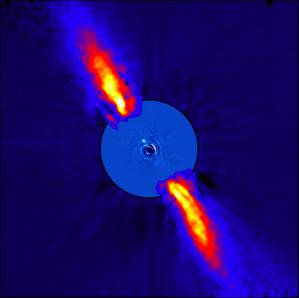Glossary term: अनुकूली प्रकाशिकी
Description: जब आप रात में ऊपर देखेंगे तो आपको तारे टिमटिमाते हुए दिखाई देंगे। वायुमंडलीय हवा हमेशा गति में रहती है, और जब तारों का प्रकाश अशांत हवाओं से गुजरता है, तो यह अलग-अलग डिग्री तक विक्षेपित हो जाता है। इसीलिए हम आकाश में जो देखते हैं वह तारे के प्रकाश का एक निश्चित बिंदु नहीं है, बल्कि बिंदुओं का एक नाचता हुआ, हमेशा बदलता हुआ, विकृत क्रम है। खगोलविदों के लिए, टिमटिमाते आकाशीय पिंडों का मतलब है कि वे उनकी छवियों को उतने विस्तार से नहीं ले सकते जितना वे अपनी बड़ी जमीन-आधारित दूरबीनों से ले सकना अपेक्षित हैं। अनुकूली प्रकाशिकी यह इस प्रभाव को कम करने का एक तरीका है। एक वास्तविक तारे या लेजर-प्रक्षेपित "कृत्रिम तारे" का उपयोग करते हुए, एक अनुकूली प्रकाशिकी ("एओ") प्रणाली वास्तविक समय में वायुमंडलीय विकृति की निगरानी करती है। दूरबीन में प्रवेश करने वाला प्रकाश एक विपरीत दर्पण पर निर्देशित होता है। एक कंप्यूटर द्वारा नियंत्रित, दूरबीन का दर्पण, वायुमंडलीय विकृति का विरोध करने के लिए लगातार सही तरीके से विकृत होता रहता है।
Related Terms:
See this term in other languages
Term and definition status: The original definition of this term in English have been approved by a research astronomer and a teacher The translation of this term and its definition is still awaiting approval
The OAE Multilingual Glossary is a project of the IAU Office of Astronomy for Education (OAE) in collaboration with the IAU Office of Astronomy Outreach (OAO). The terms and definitions were chosen, written and reviewed by a collective effort from the OAE, the OAE Centers and Nodes, the OAE National Astronomy Education Coordinators (NAECs) and other volunteers. You can find a full list of credits here. All glossary terms and their definitions are released under a Creative Commons CC BY-4.0 license and should be credited to "IAU OAE".
If you notice a factual or translation error in this glossary term or definition then please get in touch.
Related Media
beta Pictoris b
Credit: ESO/A.-M. Lagrange et al. credit link
License: CC-BY-4.0 Creative Commons Attribution 4.0 International (CC BY 4.0) icons
ESO's Very Large Telescope (VLT) at Paranal Observatory with a lunar halo
Credit: Juan Carlos Muñoz-Mateos/ESO credit link
License: CC-BY-4.0 Creative Commons Attribution 4.0 International (CC BY 4.0) icons










